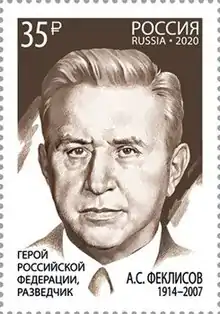Aleksandr Feklisov | |
|---|---|
 Feklisov on a 2020 Russian stamp | |
| Born | 9 March 1914[1] |
| Died | 26 October 2007 (aged 93)[1] |
| Occupation | Spy |
| Awards | Hero of the Russian Federation |
Aleksandr Semyonovich Feklisov (Russian: Александр Семёнович Феклисов; 9 March 1914 – 26 October 2007) was a Soviet spy, the NKVD Case Officer who handled Julius Rosenberg and Klaus Fuchs, among others.
Life and work
Feklisov was born in a family of railway workers. In 1939 he graduated from the Radio Faculty of the Moscow Institute of Communications, and shortly after that was sent to a training school of the Main Directorate of State Security, where he specialized in the United States.[1]
From 1941 to 1946 Feklisov worked out of the Soviet consulate office in New York City,[lower-alpha 1] first as a radio operator and then as a field officer. His supervisor was Senior NKVD Case officer Anatoli Yatskov (alias Yakovlev). Part of Feklisov's duties included recruiting espionage agent prospects from those sympathetic to the Communist Party of the United States and its auxiliary secret apparatus.[1][4]
Rosenberg was among these recruits. In the period from 1943 to 1946, Feklisov reported at least 50 meetings with Rosenberg. He stated that Rosenberg provided important top secret information about electronics and helped organize an industrial espionage ring for Moscow, but "didn't understand anything about the atom bomb." Feklisov stated that Ethel Rosenberg, as a "probationer", did not meet directly with her Soviet agent handler. He also said she "had nothing to do with this" and was "completely innocent." Feklisov once wrote that Julius Rosenberg was the only agent that he viewed as a close friend. He, in response, told Feklisov that their meetings were “among the happiest moments of my life.”[5] Feklisov was also the Case Officer for Joel Barr and Alfred Sarant, two other members of the Soviet Atomic Spy Ring. In April 1950 Feklisov returned to the USSR.[1]
Feklisov was transferred back to the United States and became the Washington, D.C. Rezident, or KGB Station Chief, from 1960 to 1964. His cover name at that time was Aleksandr Fomin. As PGU KGB Rezident, Feklisov (Fomin) proposed what became the basis for resolving the Cuban Missile Crisis: removing missiles from Cuba in exchange for a promise that the United States would not invade the island nation.
Feklisov died on 26 October 2007 in Moscow at the age of 93.[6][7][8]
Legacy
Feklisov was portrayed by Harris Yulin in the 1974 film The Missiles of October, and by Boris Krutonog in the 2000 film Thirteen Days.
Notes
See also
References
- 1 2 3 4 5 6 7 Феклисов Александр Семенович. svr.gov.ru
- ↑ "6th REISSUE" (PDF). media.defense.gov. 28 July 2021. Archived from the original (PDF) on 5 December 2023. Retrieved 5 December 2023.
- ↑ "3RD REISSUE" (PDF). www.nsa.gov. 1943. Archived from the original (PDF) on 13 August 2013. Retrieved 5 December 2023.
- ↑ Aleksandr Feklisov. famous-trials.com
- ↑ Stanley, Alessandra (16 March 1997). "K.G.B. Agent Plays Down Atomic Role Of Rosenbergs". Times Online. Retrieved 24 June 2008.
- ↑ "Alexander Feklisov. KGB agent who had a hand in some of the Soviet Union's most striking intelligence coups of the postwar period". The New York Times. London. 1 November 2007. Retrieved 24 June 2008.
- ↑ Weil, Martin (3 November 2007). "Alexander Feklisov, 93; Key Soviet Spy in U.S." The Washington Post. Retrieved 24 June 2008.
- ↑ Martin, Douglas (1 November 2007). "Aleksandr Feklisov, Spy Tied to Rosenbergs, Dies at 93". The New York Times. Retrieved 24 June 2008.
Further reading
- Feklisov, Alexander, The Man Behind the Rosenbergs: Memoirs of the KGB Spymaster Who Also Controlled Klaus Fuchs and Helped Resolve the Cuban Missile Crisis, New York: Enigma Books, 2001. ISBN 1-929631-08-1
- Trahair, Richard C.S. and Robert Miller, Encyclopedia of Cold War Espionage, Spies, and Secret Operations, New York: Enigma Books, 2009. ISBN 978-1-929631-75-9
- http://www.warheroes.ru/hero/hero.asp?Hero_id=4853